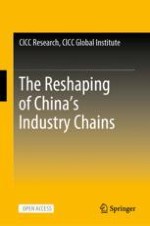Open Access 2024 | Open Access | Buch

The Reshaping of China’s Industry Chains
verfasst von: CICC Research, CICC Global Institute
Verlag: Springer Nature Singapore
Open Access 2024 | Open Access | Buch

verfasst von: CICC Research, CICC Global Institute
Verlag: Springer Nature Singapore
This open access book offers a comprehensive analysis of the opportunities and challenges facing the development of China’s industry chains in a changing landscape. As the trend of deglobalization is intensifying, the global supply chain has suffered from external shocks, prompting both the private and public sectors to reflect on the stability of the supply chain. As such, governments are putting greater emphasis on the resilience and “security” of industry chains.
How will the changing circumstances across the globe affect China’s industry chains? This book suggests that amidst the trend of deglobalization, it is important for China to leverage its advantages in economies of scale to improve both the efficiency and security of industry chains. By examining the current state of global trends, international trade, and industrial policies, the book outlines potential pathways of the development of global supply chains, and provides insights on the challenges and opportunities for China. This book also focuses on strategically important sectors in the digital, green, logistics, and manufacturing industries, presenting an in-depth discussion of the prospects of each industry chain.
Being both readable and academically rigorous, this book is well-suited for readers from in the fields of public policy, economics, finance, and for those who seek to better understand the reshaping of China’s industry chains. The work cites information from various sources, including academic journals, policy institutions, and a network of primary sources such as industry experts and renowned academics.